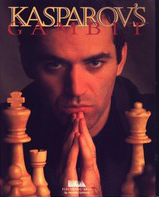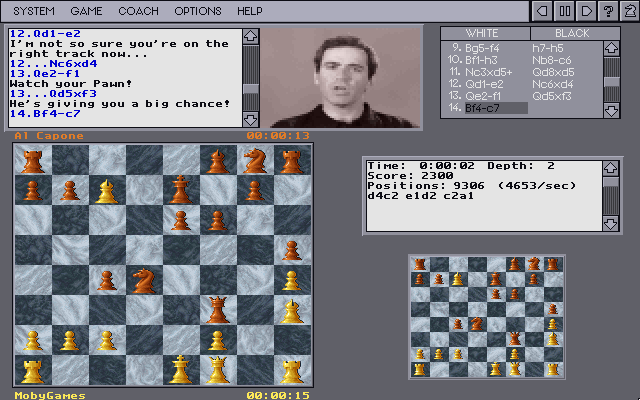Kasparov's Gambit
Home * Engines * Kasparov's Gambit

Kasparov's Gambit,
a commercial Kasparov licensees [2] chess program for x86 PCs running the MS-DOS operating system, released by Electronic Arts in 1993. It had a SVGA isometric graphic chessboard, and the license of the in that time world's reigning chess champion, Garry Kasparov. During game play, Kasparov pops up in a video window to give advice and context sensitive kibitzing.
The engine and graphics was developed by Heuristic Software, MobyGames credits Julio Kaplan, Salim Benbahmed and Don Dailey as programmers, and Garry Kasparov, Larry Kaufman, Marc Leski, Eric Schiller, and Robert Burger as Chess Consultants [3] . The engine was based on Heuristic Alpha and its successor Socrates by Dailey and Kaufman. While Socrates was written in 386 assembly, the majority of Kasparov's Gambit engine was written in C, with the 'loader' for the sound and video written in 386 assembly. This last was written by Hugh S. Myers a consultant brought to the project by Electronic Arts. Interesting to note that all participants working for Heuristic Software were either nationally or internationally rated chess players.
Screenshot
Kasparov kibitzing [4]
History
Larry Kaufman on the initial release and history of Kasparov's Gambit in Computer Chess Reports 1993 [5] :
As for the Socrates (aka "Titan") programs of Don Dailey and myself, they are finally making their commercial debut. Here is the story. After completing the "C" language program "Alpha" for Heuristic Software, which was never marketed despite winning the second Harvard Cup, we developed a new 386 assembly-language program for Heuristic Software called "Socrates", which won the third Harvard Cup, defeating three out of five grandmasters in Action chess games, including a victory over the year's U.S. Champion, Patrick Wolff. We then went on to develop a new "C" language program on our own, called "Titan", which won the 1993 ACM International Computer Chess Championship. We then "traded" that program for Socrates; we felt that Socrates should be even stronger than Titan once we incorporated key improvements used in Titan into Socrates. After all, since Socrates is in assembly language, it should be stronger than Titan if they use similar algorithms. We have now put many improvements into "Socrates", and are finally marketing it, thru a company called MDI, under the name "Socrates 3.0".
Meanwhile Titan, which won the title under the name "Socrates II", was purchased by Electronic Arts to be the chess engine of the mass-market program "Kasparov's Gambit". EA had intended to use Alpha for this, but our ACM title changed their plans. Kasparov's Gambit has just come out. Electronic Arts claims that it contains the chess engine that won the ACM tournament, but my own tests on the commercial version show that in the process of putting the ACM program into KG, something went wrong. Gambit in its initial release has many bugs and does not play the same chess at all as the ACM winner. Knowledge of bishop mobility appears to be missing, as does some other chess knowledge, and Gambit appears to run only about 50-60% of the speed of the ACM program in positions (without bishops) where the two do play and evaluate identically. There are also bugs in the features and the time controls, and the program is rather difficult to use (perhaps because it has so many features). One good thing I can say is that the 3d graphics are superb. In my opinion this product was released prematurely, and Don and I disclaim any responsibility for its playing strength. EA has revealed plans for a "patch", perhaps to be made available over bulletin boards. I have tested the patched version, and have confirmed that most or all of the bugs have been corrected. The new version does play identically to the ACM program and runs at 70-75% of the speed, so it should rate just 30 points below the ACM program. The corrected version should be in stores in November. To check whether a version of Gambit is the corrected or faulty version, look at the file date for "Gambit.exe". If it is October '93 or later, it has the "patch"; if before October it is the flawed version and you should inquire how to get the "patch". With the problems corrected, I can recommend Gambit for the general public, since it has many appealing features and is both instructive and fun, and I can also recommend it for serious players who wish to keep the cost below $50.
See also
Forum Posts
- Gambit by King Yao, rgcc, November 30, 1995
- Opinions on Kasparovs Gambit program? by Dan Ritter, rgcc, January 10, 1996
- Kasparov's Gambit vs. CM4000 by Duncan Rice, rgcc, June 22, 1996
- La Máquina Preservadora 4. Don Dailey & Larry Kaufman by Luis a, Meca Foro, October 18, 2013
External Links
- Kasparov's Gambit from Wikipedia
- Kasparov's Gambit for DOS (1993) from MobyGames
- Kasparov's Gambit & Grand Slam Bridge II (1993) from amazon.com
References
- ↑ Image from Kasparov's Gambit from Wikipedia
- ↑ Kasparov licensees from MobyGames
- ↑ Kasparov's Gambit for DOS (1993) from MobyGames
- ↑ Kasparov's Gambit (1993) screenshots from MobyGames
- ↑ Larry Kaufman (1993). PC-Software. Computer Chess Reports, Vol. 4, No. 1, pp. 8-9
